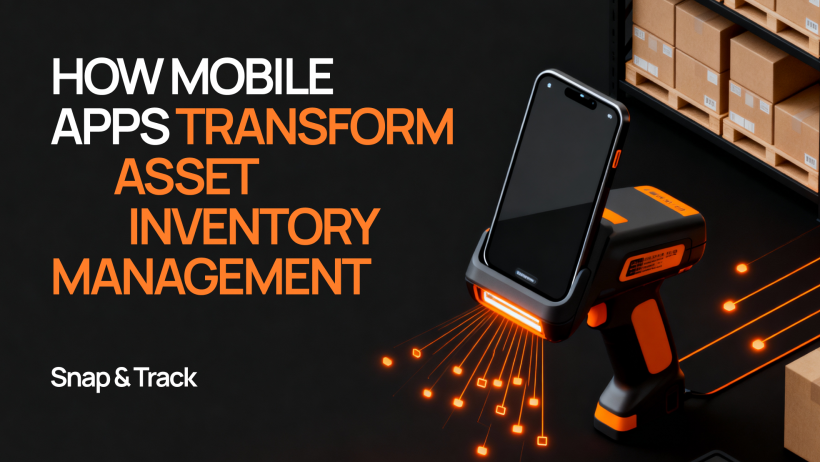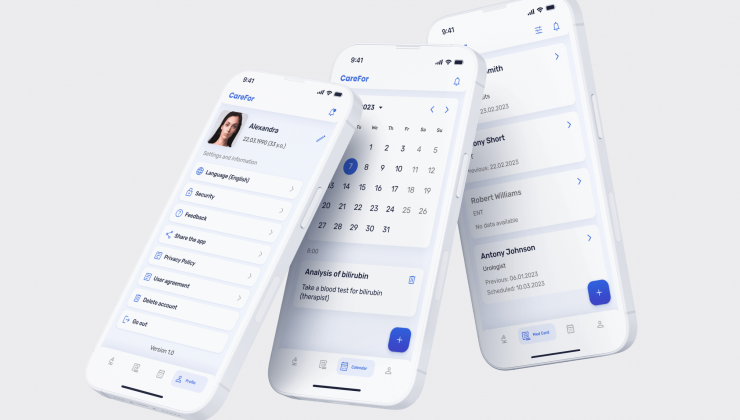Using a smartphone as a tool for real-time asset tracking has become a reality thanks to the advent of asset tracking mobile apps that combine GPS, camera-powered capabilities, and cloud technology features in a single interface. While acknowledging that manual asset tracking no longer meets the requirements for speed and accuracy, this explains why modern companies are increasingly switching to mobile inventory tracking software. Specifically, according to statistics, the global asset tracking market will reach $34.5 billion by 2032, with a CAGR of 12.8%. Given this popularity, we would like to discuss the specifics of this type of software in more detail in this article.
The Rise of Mobile Asset Tracking
Previously, companies used Excel spreadsheets and paper journals, but as the number of assets and employees grew, this became ineffective. At the same time, smartphone asset tracking apps can eliminate paper records and ensure instant access to information from any device, thereby reducing the risk of human errors and/or duplicated entries.
Also, it’s worth noting that mobile asset management software is usually flexible enough to be suitable for both large and small enterprises, so your company can easily resort to its help to prevent losses and increase process transparency. Moreover, if you’re just starting your business journey, you should definitely consider solutions for asset tracking for small businesses, as they don’t require a complex infrastructure and are predisposed to further scaling.
Key Features of Asset Tracking Mobile Apps

The capabilities of modern applications extend far beyond simple accounting – an overage asset inventory management app allows you to integrate all processes, from equipment acceptance to decommission.
Barcode and QR code scanning for instant updates
Let’s start with barcode and QR code scanning – it enables quick asset data updates. Employees simply scan the code with their smartphone camera, and the barcode and QR code inventory app automatically records the movement or status change. This eliminates manual entry and significantly speeds up the inventory process.
GPS integration for equipment inventory tracking
Modern equipment inventory apps with GPS use built-in navigation modules to track equipment. GPS-enabled asset monitoring helps you see the location of each asset and track its movements, thereby preventing its theft. All in all, for companies with large fleets of equipment, GPS tracking is an essential security and control tool.
Real-time synchronization across devices
Thanks to real-time data sync, cloud-based asset management apps ensure business information consistency across all your company's devices. This is especially useful when different departments work with the same assets. Also, such a real-time equipment tracking mobile app helps to see the current status and history of each asset, eliminating delays and data inconsistencies.
How Inventory Tracking Apps with Camera Work
Today, inventory solutions transform the way businesses manage assets, enabling ordinary smartphones to be used as full-fledged control tools.
Capturing asset details with smartphone cameras
An inventory tracking app with a camera scans serial numbers, photographs all the equipment you have, and automatically adds its images to the database. This makes inventory management clear and simplifies asset searches; moreover, such smartphone inventory tracking apps often include text recognition, reducing data entry time.
Reducing manual errors in data entry
Such errors often provoke inventory accounting inaccuracies, so to prevent them, you can use a barcode scanning asset app: with it, information is automatically saved into the system, waiting until the operator confirms it.
Integration with cloud-based databases
Connecting to a cloud-based asset inventory system provides centralized information storage, where data is automatically updated and accessible to all authorized employees. Such solutions simplify mobile ERP asset integration with other services, making the system more flexible and enabling end-to-end process automation.
Mobile Asset Management Software Benefits
If you decide to deploy mobile inventory management software (regardless of whether it's off-the-shelf or a custom one), this will provide your company with numerous benefits:
- Centralized control of assets across locations. When your assets are distributed across multiple sites, a centralized management system becomes essential. A business asset tracking solution allows you to monitor assets regardless of location, tracking their use and movement. For international companies, cloud-based asset management will also solve the problem of data access and coordination;
- Cost savings through efficient utilization. Equipment tracking mobile software can identify equipment that was used inefficiently or is idle for a long time, so, based on these analytics, you’ll be able to reallocate existing resources and optimize procurement;
- Improved accountability and compliance. A mobile accounting system will increase the accountability of your employees. Each asset has a transaction history, making all actions transparent. Real-time asset tracking will also help them comply with standards and audit requirements, especially in highly regulated industries.
If you consider custom development of inventory management software, be sure to contact us, and we’ll implement it in the most cost-efficient way to bring the highest ROI to your business.
Choosing the Best Asset Tracking Solution
The right solution directly impacts the efficiency of the entire accounting system, so let’s consider several aspects you should pay attention to before buying a specific licence or resorting to custom development.

Comparing mobile vs. desktop asset tracking systems
An asset tracking mobile app provides flexibility and instant access, while desktop systems are often limited to office settings. Mobile inventory management software benefits from its ease of use and the ability to work in the field without data loss.
Evaluating security and data privacy in mobile apps
Security is the main factor you should consider when looking for the best asset tracking solution. Specifically, modern apps of this type often use encryption and authentication (and, sometimes, are even enriched with cloud storage security). Also, it's important for businesses to ensure that their cloud-based asset inventory system complies with GDPR (or any other data protection regulations).
Considering industry-specific requirements for asset management
Some industries, such as construction and healthcare, require specialized, standard-compliant solutions. While general-purpose equipment tracking software can be tailored to specific business needs, from tool tracking to medical equipment inventory, it's also worth considering custom development to ensure a product that fully meets industry standards in your region.
Use Cases Across Industries
Overall, asset tracking software can be used in a wide range of industries where accurate inventory management is essential, so let’s check the specific use cases.
Construction equipment inventory with GPS
In construction, a GPS asset tracking system helps in tracking equipment at various sites and monitoring its usage. For instance, erectors can track locations directly from their smartphones, while managers can see the situation in real time.
Healthcare and medical device tracking
In healthcare, asset inventory management apps enable tracking equipment and sterilization, thus helping in maintaining schedules. As for real-time equipment tracking, it is especially important for preventing downtime and loss of expensive instruments; moreover, such systems help organizations meet strict safety standards.
IT asset management in corporate offices
In the IT sector, mobile asset management software simplifies the accounting of hardware and its software licenses. For example, such solutions can speed up data updates; furthermore, you can look for cloud-based asset management ones – they can instantly check equipment availability for new employees.
Implementation and Best Practices
To ensure your business asset tracking solution delivers maximum benefit, it's important to organize the implementation process correctly.
Setting up a mobile asset tracking system
Setting up an asset tracking system involves creating a proper database structure, installing apps on user devices, and defining specific user roles with access rights. So, before buying a licence, you can download an asset tracking app demo – it will help you evaluate the interface's usability and capability to integrate into existing processes.
Training employees for seamless adoption
Even the best mobile equipment tracking tool will be ineffective without properly organized personnel training. Employees need to be shown how to use an inventory tracking app with a camera to scan and update data. Also, in large companies, it's important to provide them with the system step-by-step guides and ensure technical support at every stage.
Avoiding common mistakes in asset inventory
The main mistakes companies often make are a lack of regular audits and outdated data. To avoid them, you should use real-time asset tracking and regularly reconcile with a barcode scanning asset app. You should also assign accountability for monitoring the information within the system.
Future of Asset Inventory Management

Technology is changing fast, so mobile asset management software is gradually evolving with it.
AI and automation
Artificial intelligence is already being used in enterprise mobile asset management to automatically recognize equipment and predict breakdowns. Its algorithms analyze data and provide optimization recommendations, which ultimately make smartphone asset tracking apps useful for analytics.
IoT integration
The Internet of Things enables the integration of sensors and devices with mobile systems. For example, GPS-enabled asset monitoring and IoT make it possible to track temperature, vibration, etc. As a result, the asset inventory system is transformed into an intelligent, interconnected ecosystem.
Predictive analytics
Predictive analytics allows businesses to identify potential problems before they occur, so real-time equipment tracking combined with machine learning can help plan maintenance and extend the lifespan of assets.
FAQ
Can a mobile asset tracking app work without an internet connection?
Yes, most solutions support offline mode, storing data locally and synchronizing it when a connection is restored. This is especially important for companies operating at remote sites.
How secure is sensitive company data in inventory tracking apps?
Most off-the-shelf asset tracking mobile apps use encryption and secure cloud servers, and their security level meets corporate standards and personal data protection requirements. Actually, that’s why for many companies, this is the main reason to buy asset tracking mobile software today.
What industries benefit most from GPS-based equipment inventory apps?
Construction, logistics, healthcare, as well as education most benefit from GPS-based equipment inventory apps. Wherever assets move between locations, GPS helps prevent losses and control resource usage.
Do mobile asset management solutions support multi-location businesses?
Yes, cloud-based solutions are ideal for companies with branches and distributed teams. In this case, all data is available centrally, and changes are instantly reflected in all offices.
How can businesses calculate ROI from mobile asset tracking software?
Return on investment is calculated through reduced losses/maintenance costs and increased efficiency. Usually, companies that have implemented such software report a return on investment within the first year.
Is it possible to integrate asset tracking apps with existing ERP systems?
Yes, modern solutions support ERP integration, aimed at simplified data exchange between departments. This also makes asset management part of a unified digital enterprise framework.
What's the difference between free and paid asset tracking mobile apps?
An average free inventory tracking app with a camera is good for tasks typical to SMBs, but may have limitations on functionality and the number of users; at the same time, paid versions, such as the Asset Panda asset tracking app for businesses, usually offer more advanced customization capabilities, as well as provide GPS support and integration with third-party corporate systems.


